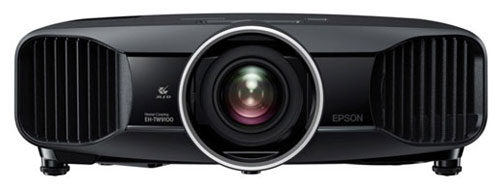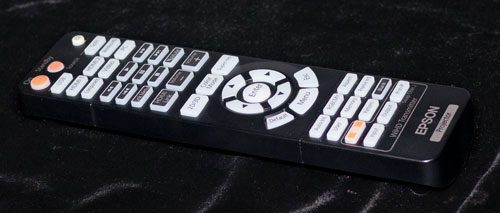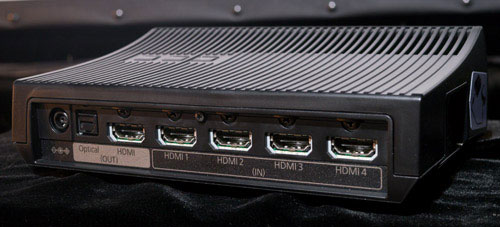HDTVTest’s second projector review happens to be from a manufacturer who doesn’t have a presence in the TV market. In fact, Epson is probably better known for office products, but the company has a presence in the home cinema space thanks to its line of projectors designed for precisely this purpose. The Epson EH-TW9100 and EH-TW9100W are the Japanese brand’s highest-end projectors, and are available from UK online stores for around £2600 and £2900 respectively, the cheaper of which omits HD wireless video capabilities. Both have the same LCD panels and optical components, and therefore have the same picture quality, although the non-wireless version comes in a more HT-friendly black colour. Both versions still have regular video inputs.
Let’s see how Epson’s top-end 3LCD effort fares against the competition!
At A Glance
| Display Technology | 3LCD |
| Approx. Lamp Life | 4000 hours |
| Lamp Product Code | ELPLP69 |
| Lens Shift | Yes, H+V |
Design
Like Panasonic projectors, Epson’s top-end projector is a rectangular-shaped unit (in that it’s wider than it is long). Strangely, the wireless-capable Epson EH-TW9100W variant comes only in white; black would be more appropriate for a darkened cinema environment. The non-wireless-capable EH-TW9100 is black, however.

The Epson EH-TW9100 features fully manual lens controls. The horizontal and vertical lens shift, as well as zoom and focus, are controlled by dials on the top of the unit. We prefer the motorized solution, at least for focus, since it allows you to stand directly beside the screen and adjust focus with a remote control: getting pin-sharp adjustment on the TW9100 will take two people. On the other hand, the lens is protected by a door which slides out of the optical path when the projector is powered on, and back in again when it’s power-off time. For assisting the positioning of the projector with the screen, there are two foot-screws at the front of the unit.
There’s also a blue power LED, which can be disabled in the menu.

Epson’s remote reminds us of those bundled with Oppo Blu-ray Disc players, in that it’s chunky, comfortable to hold, and backlit in orange. There’s an impressive number of buttons on it, with discrete input selection and also shortcuts to picture settings (Frame Interpolation, Memory Recall, Auto Iris, and so on) that would normally take more presses to access via the menu.
Naturally, the Wireless HD transmitter can be controlled with the remote, too, if your model has it.
Connections
On projector:
 |
| Rear connections on Epson EH-TW9100 |
- 2 HDMI inputs
- 1 Component input
- 1 S-Video / Composite input
- 1 PC VGA input
- 1 RS232C port for system integration
- 1 trigger port
On wireless HD transmitter (Epson EH-TW9100W only):
 |
| Rear connections on wireless receiver (EH-TW9100W only) |
- 5 HDMI inputs
- 1 HDMI output (for feeding audio to AV receiver, etc)
- 1 Optical audio output
- USB port (for charging 3D glasses)
Operation
Epson’s user menus are refreshingly basic. We have nothing against full-colour animated menus, but having basic blocks of white-on-grey text gives us a hunch that maximum R&D effort has gone into improving the projected image quality rather than on trivialities.
A quick look around the web shows that the version of the EH-TW9100 sold overseas has a THX picture mode, and therefore has been through the THX display certification process. There is no THX branding to be found on the European version, and accordingly no THX picture mode, which is strange (given that projectors tend not vary between regions, and have no real reason to given that they don’t have tuners). Provided that there is a picture mode of equivalent accuracy and performance, the loss of this will not be a huge issue. (Oddly, the manual provided with our European unit makes reference to the missing mode, albeit with a footnote explaining that not all models have the feature). We’ll find out if this is a limitation when we calibrate the projector.
![[Image] menu](/news/wp-content/uploads/2018/04/hardware_Epson-EH-TW9100_image.png) |
| [Image] menus |
The main picture menu is called “Image”, with the top level picture preset mode being called [Color Mode]. It’s essentially become an unwritten rule at this stage that when faced with this option, a “Cinema” or “Movie” mode is the one to reach for, since it’s usually the most accurate (we can interpret that as some measure of respect for the cinematographers’ wishes by manufacturers, although we argue that the benefits of accurate video should extend beyond films). On the Epson EH-TW9100, the “Cinema” option presents an incredibly wide colour gamut, which has the effect of making our consumer HD sources appear insanely saturated. Help is at hand, because the EH-TW9100’s “Natural” mode is extremely accurate (we’ll discuss this more during the Calibration section).
There are also “Dynamic” and “Living Room” modes, which prioritise light output at the expense of overall picture quality. We’d hope that home cinema projectors are being installed in home cinema rooms which have been light-treated, and that nobody will feel the need to reach for these modes, which push out ultra-bright, but tinted images.
There’s an [Abs. Color Temp.] option, which comes set to “6500K” (we’ll find out how close to 6500K it is during the calibration), and a secondary adjustment, labelled [Skin Tone]. Both of these settings affect white balance, and change the tint of the image. There’s a [Sharpness] control which can optionally be split into horizontal/vertical and high frequency/low frequency controls (labelled in user friendly terms, “Thick Line” and “Thin Line”), [Power Consumption] (we left this on “Eco” because the EH-TW9100 can put out a sufficiently bright image already), and an [Auto Iris] control which can be left off entirely, or set to “Normal” or “High Speed”.
![[Advanced] menu](/news/wp-content/uploads/2018/04/hardware_Epson-EH-TW9100_advanced.png) |
| [Image] menus |
Meanwhile, there’s an [Advanced] menu which leads to controls over gamma, greyscale tracking, and three-axis colour management. Interestingly, there’s also a toggle over whether or not the projector clips whiter-than-white shades, which has, ostensibly, been pounced on by the marketing department: it’s not just called “Super White”, this control is called “EPSON Super White” (it’s the same as every other manufacturer’s implementation of a switch which enables or disables clipping of whiter-than-white shades).
There are a few more picture controls scattered elsewhere. The “Signal” tab contains control over Frame Interpolation features, as well as another edge enhancement control (we presume it’s been placed here to differentiate it for marketing reasons). Drilling down another level into [Advanced], there’s a [Noise Reduction] control (which we don’t need), an option to turn on [Overscan] (we left it off, to see the whole image and to avoid scaling artefacts), and an option to change [Image Processing] from “Fine” to “Fast” (for reducing input lag with video games).
And, last but absolutely not least, we have an “Extended” menu which houses the [LCD Alignment] feature. We’ll go into this in depth later in the review.


Thanks for the review.
Are the two convergence pictures from the first unit or the replacement unit?
@David: It was from the first unit which prompted us to ask for a replacement unit.
Warmest regards
Vincent
i have been using crt projection for 7 years now and my twin decided to get the epson eh tw9100w. his unit is the american model imported to australia. It has the thx and 3d thx modes. The picure quality is dramatically better in thx mode compared to cinema and natural. The only issues i have found that annoy me is the crushingly bright whites. The superwhite correction dims it but does correct it. The pixel alignment looks spot on at 2-3 screen heights back but up close it looks more like RGB phosphur on a crt tv. In other words side by side. It really pisses me off that the panels are not perfectly align. You loose brightness and contrast in theory but it looked good.
You guys should have used normal lamp instead of eco. I agree the 2d performance is too bright in normal but eco looses red and leaves you with a blue green image. I think for the price it is hard to top. Its much better than the jvc dila x9 in 3D but jvc wins hands down in 2D.
The epson has black blacks in thx modes and no visible screen door effect which blew me away along with 3d quality and brighness.
I can’t stand the input lag though. My ecp4500 7 inch crt will beat the pants off any tv or non crt projection due to the analogue processing. The tw9100w is near impossible to play games on due to the input lag. Call of duty feels more like battlefield but is playable. Killzone 2 is the hardest due to to its weight control input. Movies lag aswell no matter what extra processing you lessen or turn off. Watching a movie, the picture arrives what seems like half a second after the audio from my amplifier.
There is no motion blur i can see from the 3lcd tech which was a suprise.
We have have 150 inch screen size which the tw9100 handles with brightness to spare. Being our first digital lamp based projector we on the whole are amazed at the image quality. We admittadly are using a blue (heavenly scent) wall with no discolouration in normal mode. I have a 120 inch electric screen but we will get a proper fixed screen.
I tested black performance and contrast with the dark knight and was anticipating on pointing out the lack of real contrast and blue blacks but i was gob smack too see black blacks and just about every detail possible in the night city sky after the prologue.
I just don’t like the brightness on normal. Too high. eco is comfortable but lacks red enough red. I think 2D at maybe 200 inches then the brightness would be perfect but 150 inches is good for 3d.
However the normal brightness is great for playing in high ambient light.
Wireless HDMI has no percievable difference in quality or lag. Deep colour is turned off over wireless though but its not percievable.
We managed to get this $3999 AUD projector for $3396 so it is fantastic value for money.
Very sharp picture and would recommend.
@Chris
When you say Eco lacks red, how are you measuring that? By observing the picture, or with a probe?
I Purchased a TW9000w a few months ago before the TW9100w was released from an authorized Epson Australia Dealer. The alignment was atrocious (much worse than the picture of your first unit). I sent it back to Epson and they used the panel align function and sent it back.
It was even worse when they sent it back and this time the Green panel was way off, so they fixed something and made something else worse.
I got back in touch with Epson again and they said that it was normal for projectors to have that error and they would not accept it back again. (so much for a 3 year warranty)
So to cut a long story short I sold the unit at a big loss and will never buy Epson again. I mean whats the point of buying local with from an authorized dealer if they dont cover unacceptable panel alignment with the warranty?
just by observation, no measuring equipment. i have since tested it on a white wall and although the white is certainly white compared to a blue wall. In eco mode it still seems to loose a bit of red. It doesn’t just look dimmer. Mind you i was using thx mode and i don’t know how natural/cinema/dynamic fair.
THX is really good. unfortunate you didn’t get the THX model to test.
I compared the picture of resident evil after life on panasonic 42 inch full HD viera and the epson eh tw9100w. The motion is far better on the plasma, the epson isn’t bad but lacks some clarity. The epson does dark detail and shadows very well, about on par with plasma. The one major issue in my opinion is the crushing of bright whites. It looses substantial detail in bright white scenes.
something the european model seems to have that the US model lacks is the lcd alignment. It’s not in the extended or any other menu setting. Lucky the allignment is pretty good on our model.
There is generally little to no ghosting in 3D. Turning the the 3D brightness setting to low eliminates all crosstalk and brightness doesn’t get dim even in low mode. High brightness gives a very bright 3d image. I think crosstalk also has to do with the stereoscopic photography because there are some scenes in resident evil after life bluray where both bright and dark scenes look naturall and don’t ghost at all in high mode. Half the movie does have ghosting. I tested an undersea doco triple 3d bluray pack. About 60% of all photography is excellent with no crosstalk. But sharks 3D has alot of aweful crosstalk and just poor stereoscopic convergeance which leaves you with a splitting head ache.
The 480hz shuttering is great in that there really is no flickering. Only when looking outside in sun can you persieve the shuttering effect.
pros: 3D brightness, brilliant colour, good black detail, hard to beat for the price.
cons: input lag, so so motion resolution, crushing bright whites.
We are happy with the epson eh tw9100w as it isn’t the best at anything but does everything it can quite well.
If 3D is your priority then this projector is for you.
when we get a good qaility fixed screen i will update.
thanks
@Geoff:
Sorry to hear that.
As I said in the review, I don’t see the panel alignment feature as something to rely on.
@Chris:
We did a full calibration on the projector, so any tints would be neutralized.
Hi a newbie here a researching my first projector and looking at this price bracket – currently favour the sony vpl-hw50 but this interests me as it has wifi so reducing wires would appease the wife. Would be used primary for movies with some gaming
I am a little confused tho with comments around lag? Surely if sound and motion are not in sync then this projector is not fit for purpose as all movies would be like watching a pirate version? Do people actually spend thousand and accept a basic failure or am i misunderstanding something? Is the lag just with wifi?
Comments and advice appreciated
Hi Simbo,
The lag I tested was with the wired HDMI inputs (not the wireless transmission).
AV receivers feature “lip sync delay” controls which are used to compensate for input lag on TVs and projectors. AVRs let you delay the audio so that it gets back in sync with the projector.
Hello David,
When considering 2d image, which projector do you find best between HW50 and epson 9100 and why? Thank you
“although it isn’t up there with the absolute best performers on the market when it comes to black depth”
Oh yes, better black level projectors cost 2 to 4 times more than the Epson. It’s the best in i’ts price range.
For more analytical review, see the projectorreviews site.
@Kubensky
Sorry, that’s totally untrue. The Epson EH-TW9100 costs around £2600 online.
The Sony VPL-HW50 is an example of an overall better projector, in terms of image smoothness, convergence, and deeper black level, and costs about £2700 – certainly in the same price range.
Dear David
I am looking at purchasing a projector but am not sure what to buy. I am looking at the Epson EH TW9100W as i have purchased Epson printers before and i have never had a problem.
The projector would be used for things like movies, presentations and gaming.
I would like to purchase a projector that is not only good picture quality but also one the Lamps dose not cost a fortune to replace, can you advise me on what i should be looking for.